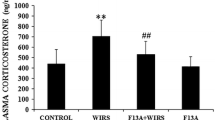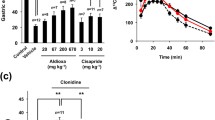Abstract
Combining restraint with cold temperature (4°C) consistently induces gastric ulceration in rats after 3.5 h. The cold restraint-stress (CRS) method provides a suitable model for acute ulcer investigations. This study compares the antiulcer activities of lansoprazole (a proton pump inhibitor), PD-136450 (CCK2/gastrin receptor antagonist) and ranitidine (histamine H2 receptor antagonist) on CRS-induced gastric ulcers in rats. The results have shown that lansoprazole, which is a potent anti-secretory agent, provides complete protection in this model of ulcer formation. The use of indomethacin pretreatment to inhibit the prostaglandin (PG) synthesis and NG-nitro l-arginine methyl ester (L-NAME) pretreatment to inhibit nitric oxide synthase did not alter the lansoprazole-induced inhibition of ulcer index obtained in the untreated Wistar rats indicating that these two systems were not involved in the activation of lansoprazole. PD-136450, an effective anti-secretory agent against gastrin- but not dimaprit-induced stimulation, evoked a dose-dependent inhibition of CRS-induced gastric ulcers. The results show that both PG and nitric oxide pathways can influence the inhibitory effect of PD-136450 against CRS-induced gastric ulcer. The antiulcer activities of both lansoprazole and PD-136450 were compared to that of ranitidine. The results showed that ranitidine was more potent than lansoprazole and PD-136450 in inhibiting CRS-induced gastric ulcers and its effect was shown to be influenced by PG as well as nitric oxide synthase. The results of this study have demonstrated that although lansoprazole, PD-136450 and ranitidine were protective against CRS-induced gastric ulcers, the antiulcer activities of PD-136450 and ranitidine involved both PG and nitric oxide pathways, while lansoprazole acted independently of these two systems during CRS.





Similar content being viewed by others
References
Honda K, Fukuda S, Ishikawa S, Kuzuya T, Saito T (1994) Role of endogenous vasopressin in development of gastric ulcer induced by restraint and water immersion. Am J Physiol 266:R1448–R1453
Kumar PJ, Clark ML (2007) Pathophysiology of the gastrointestinal tract. In: Kumar PJ, Clark ML (eds) Textbook of clinical medicine, 7th edn. Saunders, London, pp 253–334
Senay EC, Levine RJ (1967) Synergism between cold and restraint for rapid production of stress ulcers in rats. Proc Soc Exp Biol 124:1221–1223
Schiessel R, Feil W, Wenzl E (1990) Mechanisms of stress ulceration and implications for treatment. Gastroenterol Clin North Am 19:101–120
Levenstein S (1998) Stress and peptic ulcer: life beyond Helicobacter. Br Med J 316:538–541
Robert A, Leung FW, Jauserm DG, Guth PH (1989) Potentiation of aspirin-induced gastric lesions by exposure to cold in rats. Role of acid secretion, mucosal blood flow, and gastric mucosal prostanoid content. Gastroenterology 97:1147–1158
Ritchie WP (1975) Acute gastric mucosal damage induced by bile salts, acid and ischemia. Gastroenterology 68:699–707
Garrick T, Buack S, Bass P (1986) Gastric motility is a major factor in cold restraint-induced lesions formation in rats. Am J Physiol 250:G191–G199
Moody FG, Cheung LY, Simons MA, Zalewsky C (1976) Stress and the acute gastric mucosal lesions. Dig Dis Sci 21:148–154
Bresalier RS (1991) The clinical significance and pathophysiology of stress-related gastric mucosal hemorrhage. J Clin Gastroenterol 13(Suppl 2):S35–S43
Filaretova LP, Podvigina TT, Bagaeva TR, Tanaka A, Takeuchi K (2004) Mechanism underlying the gastroprotective action of glucocorticoids released in response to ulcerogenic stress factors. Ann N Y Acad Sci 1018:288–292
Hase T, Andeson RP, Mehlman B (1975) Significance of gastric secretory changes in the pathogenesis of stress ulcer. Am J Dig Dis 20:1197–1198
Satoh H, Inatomi N, Nagaya H, Inada I, Nohara A, Nakamura H (1989) Antisecretory and antiulcer activities of a novel proton pump inhibitor AG-1749 in dogs and rats. J Pharmacol Exp Ther 248:806–815
Chandranath SI, Bastaki SMA, Singh J (2002) A comparative study on the activity of lansoprazole, omeprazole and PD-136450 on acidified ethanol- and indomethacin-induced gastric lesions in the rat. Clin Exptl Pharmacol Physiol 29:173–189
Bastaki SMA, Chandranath SI, Singh J (2002) Comparison of the antisecretory and antiulcer activity of epidermal growth factor, urogastrone and transforming growth factor alpha and its derivative in rodents in vivo. Mol Cell Biochem 236:83–94
Eissle R, Patberg H, Krack W, McKnight AT, Arnold R (1992) Effect of gastrin receptor blockade on endocrine cells in rats during achlorhydria. Gastroenterology 103:1596–1601
Schmassmann A, Garner A, Flogerzi B, Hassan MY, Sanner M, Varga L, Halter F (1994) Cholecystokinin type B receptor antagonist PD-136450 is a partial secretory agonist in the stomach and a full agonist in the pancreas of the rat. Gut 35:270–274
Garner A, Fadlallah H, Parsons ME (1996) 1976 and all that!—20 years of antisecretory therapy. Gut 39:784–786
Bastaki SMA, Hasan MY, Chandranath I, Garner A (1996) PD-136450: a CCK-B (gastrin) receptor antagonist with a novel spectrum of antiulcer activity. Gut 39(Suppl 3):A48
Bandyopadhyay D, Biswas K, Bandyopadhyay U, Reiter RJ, Banerjee RK (2000) Melatonin protects against stress-induced gastric lesions by scavenging the hydroxyl radical. J Pineal Res 29:143–151
Warzecha Z, Dembinski A, Brzozowski T, Ceranovicz P, Dembinski M, Stachura J, Konturek SJ (2001) Histamine in stress ulcer prophylaxis in rats. J Physiol Pharmacol 52:407–421
Wallace JL, Tigley AW (1995) New insights into prostaglandins and mucosal defense. Aliment Pharmacol Ther 9:227–235
Whittle BJ, Lopez-Belmonte J, Moncada S (1990) Regulation of gastric mucosal integrity by endogenous nitric oxide: interactions with prostanoids and sensory neuropeptides in the rat. Br J Pharmacol 99:607–611
Brodie DA, Hanson HM (1960) A study of the factors involved in the production of gastric ulcers by the restraint technique. Gastroenterol 38:353–360
Langtry HD, Wilde MI (1997) Lansoprazole. An update of its pharmacological properties and clinical efficacy in the management of acid related disorders. Drugs 534:473–500
Garner A, Chandranath I, Hasan MY, Bastaki SMA, Al-Tajir GK, Schmassmann A (1993) Relative merits of two novel antisecretory drugs acting via H+/K+ ATPase inhibition and CCK receptors. Gut 34:S54
Weiner H (1996) Use of animal models in peptic ulcer disease. Psychosom Med 58:524–545
Menguy R (1960) Effects of restraint stress on gastric secretion in the rat. Am J Dig Dis 5:911–916
Green FW, Kaplan MM, Curtis LE, Levine PH (1978) Effect of acid and pepsin o blood coagulation and platelet aggregation: a possible contributor to prolonged gastroduodenal mucosal hemorrhage. Gastroenterology 74:38–43
Orlando RC (1996) Why is the high grade inhibition of gastric acid secretion afforded by proton pump inhibitors often required for healing of reflux esophagitis? An epithelial perspective. Am J Gastroenterol 91:1692–1696
Playford RJ, Marchbank T, Calam J, Hansen FH (1995) EGF is digested to smaller, less active forms in acidic gastric juice. Gastroenterology 108:92–101
Slomiany BL, Liu J, Yao P, Wu-Wang CY, Keogh JP, Wang SL, Slomiany A (1990) Characterization of the epidermal growth factor receptor in the gastric mucosa. Digestion 47:181–190
Robert A, Kauffman GL (1983) Stress ulcers. In: Sleisenger MH, Fordtran JS (eds) Gastrointestinal diseases, pathophysiology, diagnosis, management. Saunders, Philadelphia, pp 612–662
Chiverton SG, Hunt RH (1989) Relationship between inhibition of acid secretion and healing of peptic ulcers. Scand J Gastroenterol Suppl 166:43–47
Robert A, Schultz JR, Nezamis JE, Lancaster C (1976) Gastric antisecretory and antiulcer properties of PGE2, 15-methyl PGE2, and 16,16-dimethyl PGE2. Gastroenterology 70:359–370
Ding M, Kinoshita Y, Katsuyama M, Kishi K, Nakata H, Hassan S, Kawanami C, Sugimoto Y, Negishi M, Narumiya S, Ichikawa A, Chiba T (1997) Distribution of prostaglandin E receptors in the rat gastrointestinal tract. Prostaglandins 53:199–216
Ligumsky M, Goto Y, Debas H, Yamada T (1983) Prostaglandins mediate inhibition of gastric acid secretion by somatostatin in the rat. Science 219:301–303
Nylander O, Berglindh T, Obrink KJ (1986) Prostaglandin interaction with histamine release and parietal cell activity in isolated gastric glands. Am J Physiol 250(5 Pt 1):G607–G616
Tanaka S, Guth PH, Carryl OR, Kunitz JD (1997) Cytoprotective effect of bismuth subsalicylate in indomethacin-treated rats is associated with enhanced mucus bismuth. Aliment Pharmacol Ther 11:605–612
Takeuchi K, Kato S, Yasuhiro T, Yagi K (1997) Mechanism of acid secretory changes in rat stomach after damage by taurocholate: role of nitric oxide, histamine and sensory neurons. Dig Dis Sci 42:645–653
Pique JM, Whittle BJ, Esplugues JV (1989) The vasodilator role of endogenous nitric oxide in the rat gastric microcirculation. Eur J Pharmacol 174:293–296
Brown JF, Hanson PJ, Whittle BJ (1992) Nitric oxide donors increase mucus gel thickness in rat stomach. Eur J Pharmacol 223:103–104
Waldum HL, Brenna E, Sandvik AK (2000) The mechanism of histamine secretion from gastric enterochromaffin-like cells. Am J Physiol 278:C1275–C1276
Halter F, Barbezat GD, Van Hoorn-Hickman R, Van Hoorn WA (1980) Healing dynamics of traumatic gastric mucosal defects in the normal and hyperacid stomach. Dig Dis Sci 25:916–920
Wood JD (2000) Neuropathy in the brain-in-the gut. Eur J Gastroenterol Hepatol 12:597–600
Banski D, Sharon P, Karmeli F, Rachmilewitz D (1984) Effect of cimetidine on human gastric and duodenal prostanoid synthesis. Scand J Gastroenterol 19:457–460
Uchida K, Mitsuma T, Morise K, Kaneko H, Nagai H, Furusawa A, Nakada K, Maeda Y (1993) The role of thyrotropin-releasing hormone (TRH) in the pathogenesis of water immersion stress in rats—inhibition of TRH release from the stomach by atropine, ranitidine or omeprazole. Gastroenterol Japan 28:1–9
Konagaya T, Kusugami K, Yamamoto H, Kaneko H, Nagai H, Mitsuma T (1998) Effect of histamine on thyrotropin-releasing hormone and somatostatin secretion in rat stomach. Hepatogastroenterol 45:567–572
Author information
Authors and Affiliations
Corresponding author
Rights and permissions
About this article
Cite this article
Chandranath, S.I., Bastaki, S.M.A., D’Souza, A. et al. Attenuation of stress-induced gastric lesions by lansoprazole, PD-136450 and ranitidine in rats. Mol Cell Biochem 349, 205–212 (2011). https://doi.org/10.1007/s11010-010-0675-3
Received:
Accepted:
Published:
Issue Date:
DOI: https://doi.org/10.1007/s11010-010-0675-3




